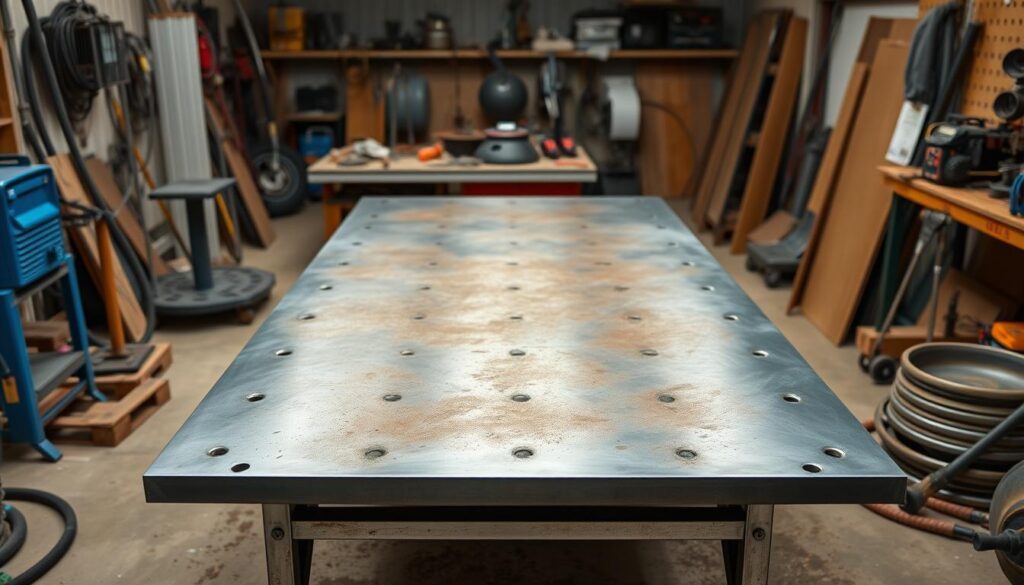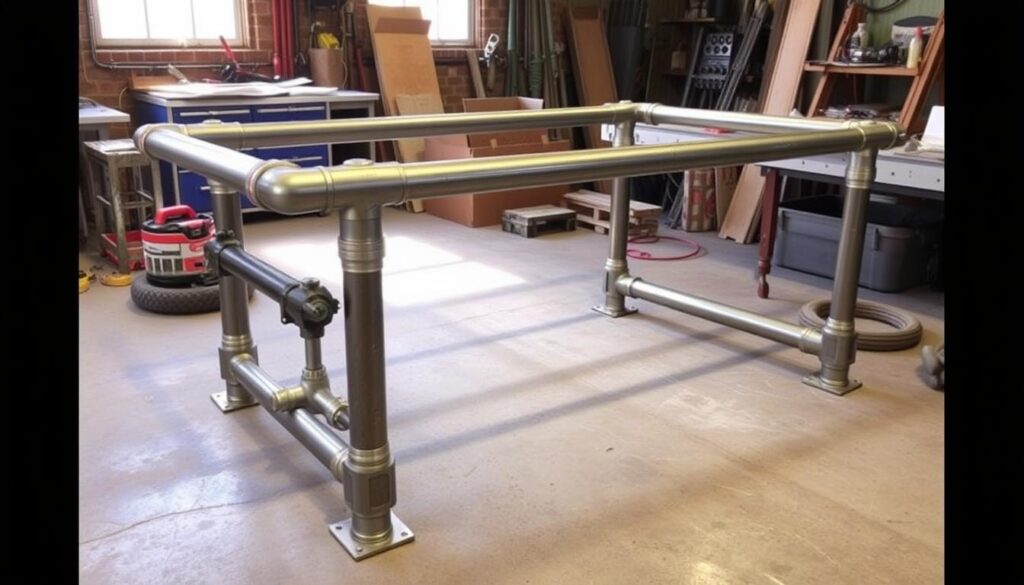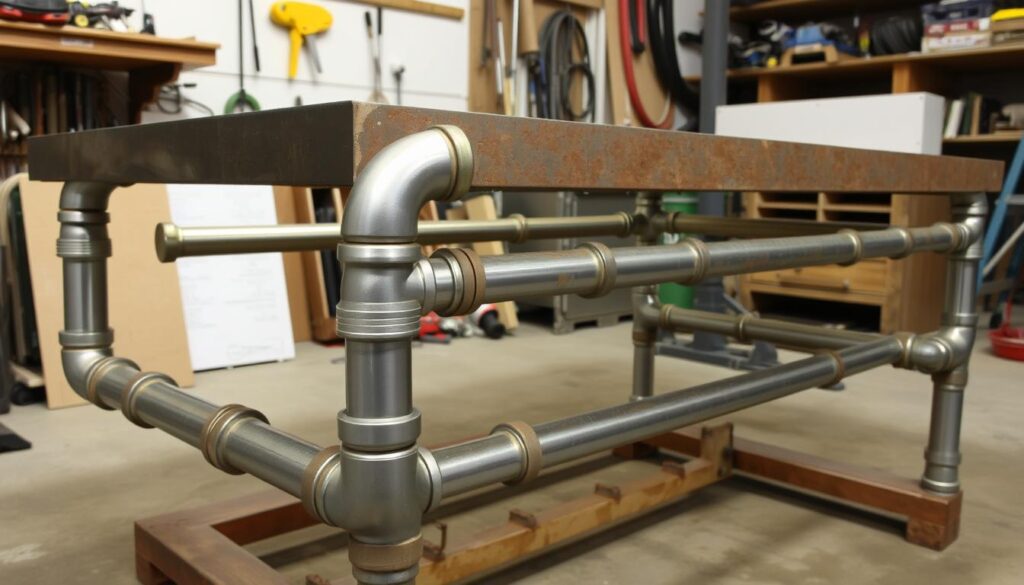We at KT-welding table offer a professional guide on picking the right pipe or channel for your welding table frame. This ensures durability and functionality. A sturdy weld table is key for a flat, stable, and durable surface. It’s perfect for various welding tasks and clamp setups, like weld, clamp, c channel, and drill.
Our aim is to help you build a nice table, your first one, with the right size and flatness. We recommend using materials like tubing, x 4, and beam. Make sure it’s level and has a caster for easy movement. As a welder, you need a reliable and efficient weld table. We’re here to guide you in choosing the right pipe or channel for your welding table frame, considering factors like bolt, tack, and jig.
With our expertise and guidance, you can make a professional-grade welding table. It will meet your needs and exceed your expectations. It provides a solid foundation for your welding projects and ensures a stable and secure table top for your weld, clamp, and other equipment.
Understanding Frame Materials for Welding Tables
It’s key to know the different steel materials for welding tables. Their thickness and cost are important. A sturdy table is crucial for your projects. A steel plate can offer the strength needed, making it easy to move around your workshop.
The top plate should match the frame’s top. This prevents any obstacles. A large table is great for big projects. You can clamp your workpieces anywhere on it.
However, a 4×4 table might be better for smaller tasks. A thicker steel plate makes the table heavier but more stable. Using pipe for the legs adds to the stability. An old table can also be turned into a welding table with some changes.
Steel tables are favored by welders for their durability and strength. When picking a frame, think about cost versus durability. You want a table that can handle welding well and last long. Here are some key points to consider:
- Material thickness: Thicker materials are stronger and more stable.
- Cost: Thicker materials cost more than thinner ones.
- Durability: Steel tables are more durable and can handle heavy use.

In summary, knowing the different steel materials for welding tables is vital. By looking at thickness, cost, and durability, you can build a reliable table. This table will meet your needs and last for years.
| Material | Thickness | Cost | Durability |
|---|---|---|---|
| Steel Plate | 1/4 inch | High | High |
| Steel Table | 1/2 inch | Medium | Medium |
| Aluminum | 1/8 inch | Low | Low |
Selecting the Right Pipe or Channel for Frame of Welding Table
At KT-welding table, we know picking the right pipe or channel is key for a welding table’s stability and use. The choice depends on welding type, table size, and clamping needs. For example, a 1″x6 flat bar can make a strong frame, and a pipe for legs adds extra support.
The table’s top is also important. It can be solid, expanded metal, or custom. It should be smooth and ready for clamps to make setup easy.
When choosing the frame material, options include scrap metal, stainless steel, and aluminum. But aluminum’s low melting point is a risk for welding tables. A solid top with a hole in the center is great for welding. A thicker top adds durability.
The table should make it easy to clamp and secure workpieces. Features like a flat bar or enough space for clamps are important.

- Material thickness and durability
- Cost vs. performance
- Clamping capabilities and ease of setup
- Table size and intended use
By thinking about these points and choosing wisely, you can make a welding table that’s stable and works well. With some planning and care, your welding table will last for many years. It will have a smooth top and enough room for your projects, whether they’re with expanded metal, scrap metal, or other materials.
Square Tubing vs. Channel Iron: Making the Choice
Choosing the right material for your welding table’s frame is crucial. You have two main options: square tubing and channel iron. We’ll look at what each offers to help you decide.
In our shop, we often pick angle iron for its strength. But for a welding table, square tubing gives a dead flat surface. This is key for precise welding. We also add cross braces for extra stability.
Benefits of Square Tubing
Square tubing is strong and durable, making it great for welding tables. It comes in sizes like x 48 and x 60, fitting various projects. It also works well with enough clamps and fixturing for a firm hold.
Advantages of Channel Iron
Channel iron has its own benefits. It’s easy to use and versatile, often used around the shop. It’s also cost-effective, especially when paired with cold rolled steel. Plus, it works well with a hydraulic jack for convenience.
| Material | Size | Weight Capacity |
|---|---|---|
| Square Tubing | 2x2x1/4 | 56 kips (56,000 lbs) |
| Channel Iron | 3x3x1/8 | 32 kips (32,000 lbs) |
Essential Frame Design Considerations
Designing a welding table frame requires careful thought. It must be strong, stable, and work well for welding. At KT-welding table, we know how crucial the frame’s design is. It should hold the table’s surface and any extra features, like shelves or clamps, made from square tube or channel iron.
A good frame lets you clamp anywhere on the table. This makes it very versatile. Using square tubing and steel plate creates a solid structure. Tig welding and fab techniques make the frame even stronger. For lighter tasks, a simple tack weld works. But for heavier tasks, a 10 x 10 inch steel plate is needed.
When designing a welding table frame, consider these key features:
- Flatness: The frame must be flat and level for accurate welding.
- Stability: It should be stable to prevent movement or vibration that can ruin the weld.
- Clamping: A good clamping system is essential for holding the workpiece securely, using a fixture or clamp anywhere on the table.
By focusing on these aspects and choosing the right materials and techniques, you can create a welding table frame that meets your needs. Whether for a small shop or a big industrial setup, using square tube, channel iron, or other materials is key.
| Material | Thickness | Weight Capacity |
|---|---|---|
| Square Tube | 1/4 inch | 500 lbs |
| Channel Iron | 1/2 inch | 1000 lbs |
| Steel Plate | 1 inch | 2000 lbs |
Frame Construction Techniques and Tips
Building a weld table starts with a solid frame. A well-made frame keeps the table flat and level, which is key for precise welding. Use a c channel or beam for the frame to add strength. When putting the frame together, clamp the parts and drill pilot holes to avoid damage.
Choose 2″ x 4″ tubing for the frame for a strong base. A jig helps make accurate welds. For the table top, use at least 1/4″ thickness for light work and 1/2″ for heavy work. Always level the table top and tack it to the frame to avoid warping.
For building the frame, use a welder with a high duty cycle to avoid overheating. Also, pick a caster that can hold at least 350 lbs to support heavy loads. With these tips and the right materials, your weld table will last for many years.
Proper Joint Preparation
Cleaning and deburring the joint area is key for strong welds. Also, a flat weld table helps prevent warping.
Welding Sequence
The order in which you weld matters for the frame’s strength and stability. Weld in a pattern that alternates sides to keep the table flat and prevent warping.
Reinforcement and Support Structures
At KT-welding table, we know how crucial reinforcement and support are. A thick plate, like cast iron, makes a solid base for the table. It offers a flat surface for welding. A vise on the table keeps the workpiece steady, making welding precise.
A sturdy frame is built with square tube or channel iron, topped with a thick plate. This setup can handle heavy loads. Plasma cutting is used for detailed designs in the table’s structure. For example, a forklift helps move heavy materials, and a fixture holds them in place during welding.
Key points for reinforcement and support include:
- Cross-bracing for extra stability
- Gusset placement to prevent warping
- Techniques for distributing loads
A welding table with a square tubing or channel iron frame and a thick plate top is very durable. A vise and fixture help with precise welding and support for heavy loads. These elements ensure the table is ready for any welding task, big or small.
| Material | Thickness | Weight Capacity |
|---|---|---|
| Cast Iron | 1/2 inch | 1000 lbs |
| Steel Channel | 1/4 inch | 500 lbs |
| Square Tubing | 1/2 inch | 2000 lbs |
Additional Features for Enhanced Functionality
We add features to make the weld table better, like storage and mobility. A table that’s the right size and flat is even more useful with these extras. For example, a jig helps with accurate welds, and a clamp keeps the workpiece steady.
A sturdy frame can be made with a c channel or beam. A drill is handy for making holes for bolts. A flat table top is key, made from something that can handle high heat.
A level ensures the table is even, and casters make it mobile. Tubing frames the table, and bolts hold the top in place. A tack keeps the workpiece steady, and a x 4 beam adds strength.
Features like storage and casters can boost a weld table’s use. They make the table more useful, efficient, and easy to move. A table with these extras is a smart buy for welders, good for many projects.
When making a weld table, think about what the user needs. The right size and flatness are important. Extras like storage and mobility make the table better for welding.
Conclusion: Building a Professional-Grade Welding Table Frame
As we wrap up our guide on building a top-notch welding table frame, we stress the need for a strong, well-thought-out design. The steel tables, frame work, and making sure the top is flush with the surface are key for a reliable welding setup. By using the tips and techniques we’ve shared, you can i’ll make a welding table that fits your needs and improves your welding skills.
Choosing 1″x6 tubing or enough to build a strong frame with flat bar is important. The goal is to have a top with 1 solid, top surface that can handle your work. Adding pipe for legs and smart design elements lets you allow you to clamp your projects securely and work confidently.
Creating a x 6 welding table frame is the base for making solid top professional-grade results. By putting time and effort into building a sturdy, functional frame, you’ll boost your welding skills and get amazing results.


